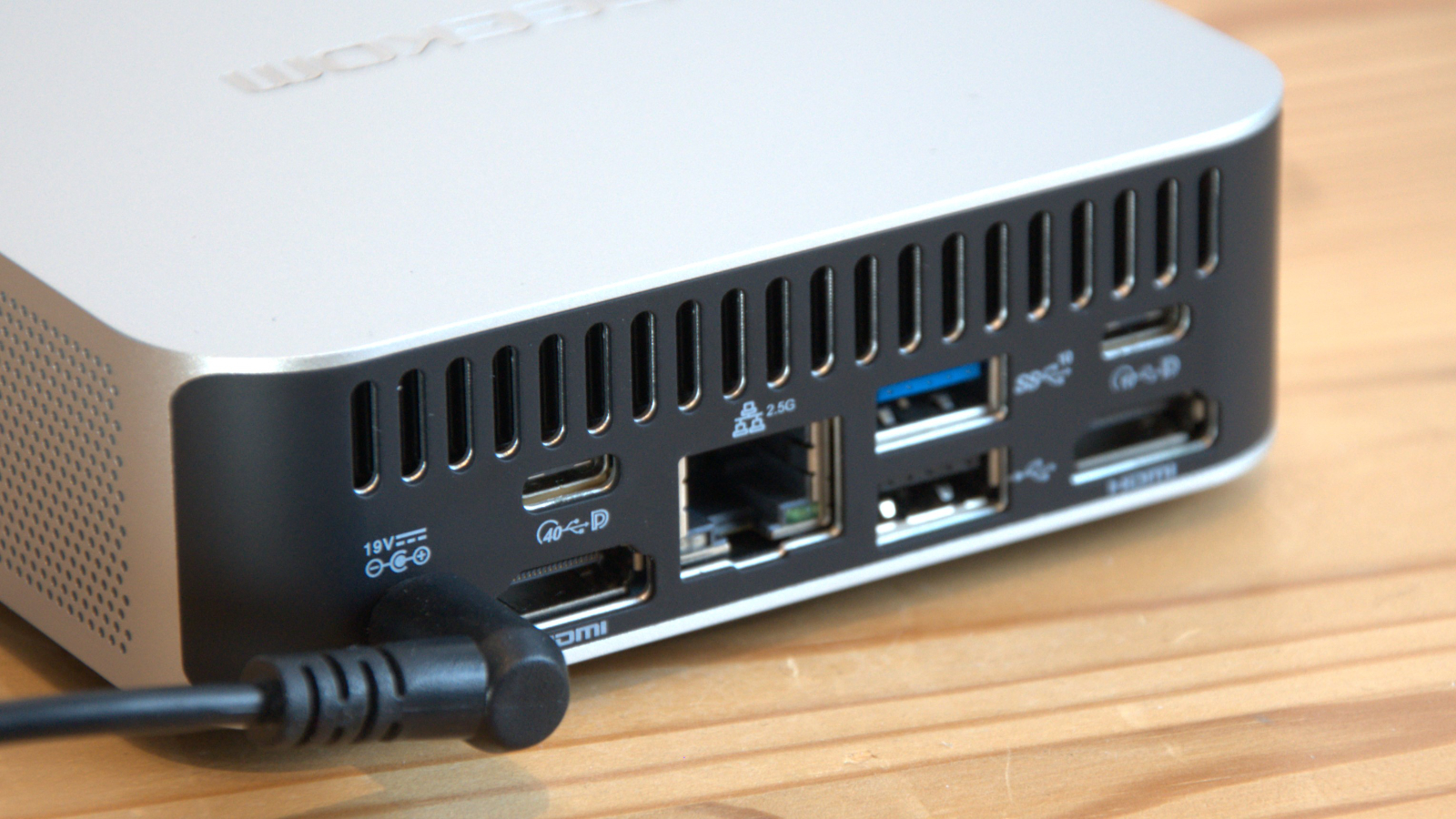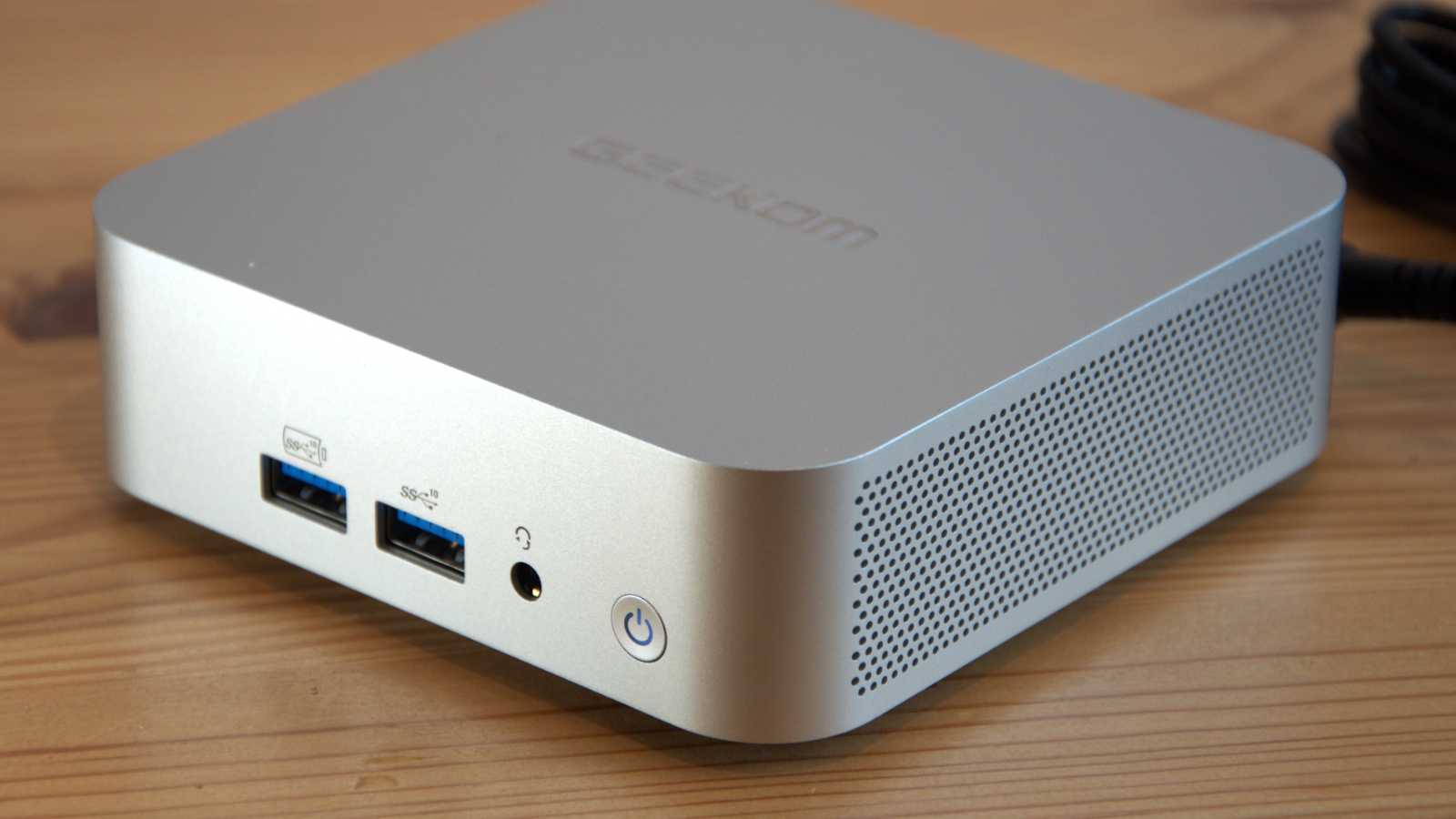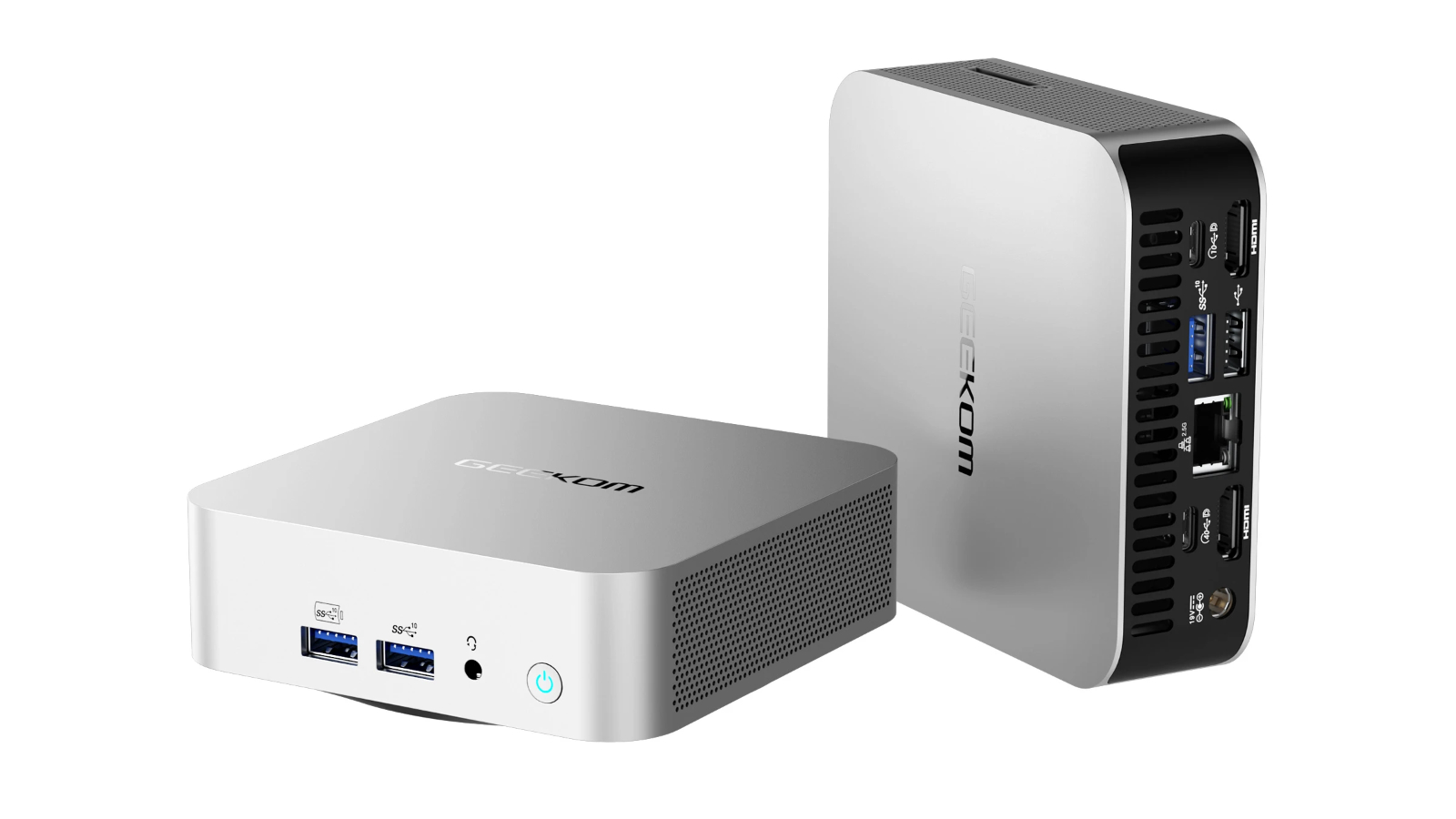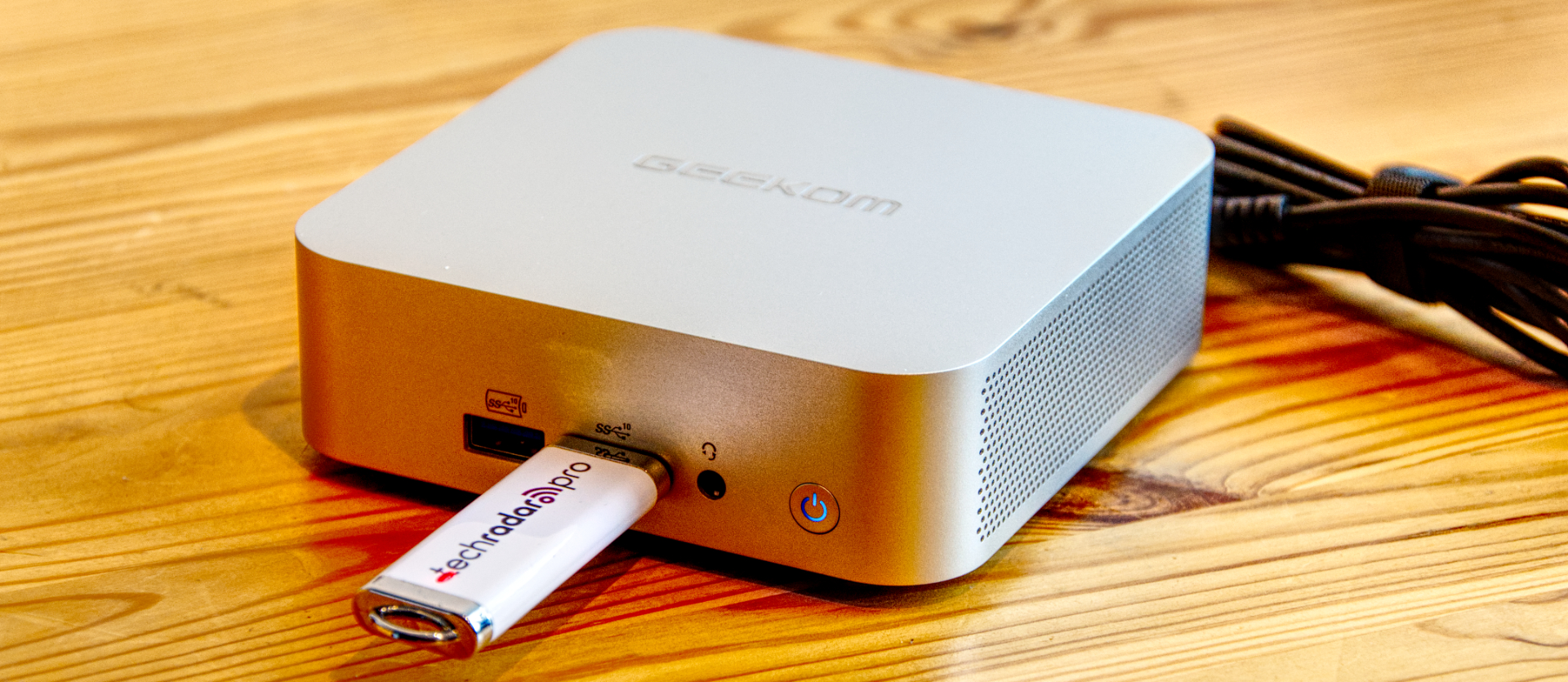TechRadar Verdict
While the power in the A8 is impressive, fan noise takes some of the shine off this lovely NUC. And, with new Zen 5 chips only months away, maybe investing heavily in a Zen 4 NUC right now isn’t a great plan.
Pros
- +
Powerful CPU
- +
Decent graphics performance
- +
Lots of USB ports
Cons
- -
Noisy
- -
Single M.2 slot
- -
No Thunderbolt
- -
Expensive
Why you can trust TechRadar
30-second review
A few NUC makers have been using larger enclosures recently, but Geekom engineers didn't get that memo, and the A8 is a tiny machine measuring just 112.4 mm square and 37mm high.
Having tested many of the best mini PCs, typically, the issue with making a machine this small is space for ports, but the A8 still manages to find room for many USB ports, dual HDMI outputs and 2.5GbE LAN.
The caveats in this design are that it only has room for a single M.2 2280 slot, making cloning the Windows installation to a fresh drive more challenging and the fan noise.
With such a small enclosure and a powerful platform, the fan can run at full speed even when idle to keep the system cool. It can be heard at any velocity, although mounting it onto a monitor might make this noise less obvious.
When benchmarking this hardware, it became excessively warm to the touch, suggesting that even at maximum air displacement, the cooling system isn't able to handle the heat generated by the Ryzen 9 8945HS. While we didn't test this assertion, the Ryzen 7 version of the A8 might be better in this aspect.
With all this computing power in such a small package, these issues shouldn't be a huge surprise. What was less expected was how expensive the A8 can be, especially outside the USA. Compared with similarly specced machines by GMKtec and Minisforum, the cost, even in America, is high.
While the A8 exhibits great build quality and finish, it doesn't provide any mitigating features to explain why it is so priced.
Sign up to the TechRadar Pro newsletter to get all the top news, opinion, features and guidance your business needs to succeed!
Geekom A8: Price and availability
Save 5% on the Geekom A8 mini PC with code TECHA8
Buy the Geekom A8 mini PC today and get an extra 5% off when you use the code TECHA8
Offer available from the official US site and the official UK site and Amazon.
- How much does it cost? From $700/£700/€800
- When is it out? Available now
- Where can you get it? Directly from Geekom and online retailers
The Geekom A8 comes in only two SKUs, one using the Ryzen 7 8845HS processor and the more potent Ryzen 9 8945HS.
American customers can get the Ryzen 7 variant for $699 and the Ryzen 9 model for $849. Both designs come with 32GB of DDR5, but the Ryzen 9 gets a 2TB SSD over the 1TB on the Ryzen 7.
UK customers get a less wonderful deal where the dollar prices are directly translated into UK pounds 1:1, making them effectively 25% more expensive.
Europeans pay €799 for the Ryzen 7 and €949 for the Ryzen 9, making for an equally unattractive exchange.
Compared to other NUC makers, this product seems about $50 more expensive than a similarly specified device from GMKtec in the USA, but it is substantially more expensive for European customers.
Considering the build quality, the price for the USA seems high but plausible, whereas outside the Americas, the asking price makes it expensive.
- Value: 3 / 5

Geekom A8: Specs
Item | Spec |
|---|---|
CPU: | AMD Ryzen 9 8945HS (8 cores, 16 Threads) |
GPU: | Radeon 780M |
RAM: | 32GB DDR5-5600 (2800 MHz) (16GB x 2) Expandable to 64GB |
Storage: | 2TB M.2 2280 PCIe Gen 4 |
Expansion: | N/A |
Ports: | 1x USB 4.0 Type-C, 3x USB 3.2 Gen 2 Type-A, 1x USB 3.2 Gen 2 Type-C, 1x USB 2.0, 2x HDMI 2.0b, 3.5mm Audio Jack, SD Card slot |
Networking: | 1x 2.5GbE LAN, WiFi 6e, Bluetooth 5.2 |
OS: | Windows 11 Pro (pre-installed) |
Base Power: | 35W-54W (configurable) |
PSU: | 19V 6.32A 120.08W |
Dimensions: | 112.4 x 112.4 x 37 (mm) |
Geekom A8: Design
- Metal enclosure
- No easy access inside
- Four displays possible
On a physical scale, this machine is almost identical to the original Intel NUC, using the de facto 4-inch motherboard in an enclosure that is only just a tiny bit bigger.
The A8's metal skin feels nice to the touch, and this design exudes a solidity that some less expensive designs fail to exude. The rear and underside are plastic, but it has an elegant matte finish that works well with the metal skin on the rest of the device.
Air is drawn through the perforated sides and expelled via a vent above the I/O area on the rear. As we'll talk about later, cooling is an issue for this device, and maybe vents underneath might have helped.
The underside is chamfered into a circle on which four rubber feet have been added, and there are two threaded holes used to attach it to the VESA plate supplied in the box.
This design is mildly disappointing because access to the inside is far from straightforward. It can be achieved by peeling off the rubber feet to reveal four screws and then four more screws inside to detach a metal plate that acts as a heatsink for the M.2 drive.
Normally, if access is easy, we go inside and photograph the interior, but given that adhesively attached rubber feet tend to fall off, we passed on that adventure this time.
We know from other sources that there is only one M.2 2280 slot occupied by the 2TB drive supplied with the machine and that the branded DDR5 modules have no cooling connected to them.

Obviously, internal access was always going to be challenging on a machine like this, but Geekom didn't mitigate that with its choice to put the screws under the feet.
Where they tried harder was with the I/O, providing a significant number of USB 3.2 Gen 2 ports and USB 4.0. Using the USB 4.0 and USB 3.2 Gen 2 USB-C ports alongside the two HDMI 2.0 allows four displays driven by the A8.
However, the GPU power of the Radeon 780M isn't limitless, and running them all at 4K might be a slideshow experience, depending on how the displays are being generated.
We'd have preferred Thunderbolt and a second LAN port, but with USB 4.0, you could attach a docking station and break out many more USB ports if needed.
Except for internal access and the single M.2 slot, this is a well-considered design that makes good use of the processing platform.
- Design: 4 / 5

Geekom A8: Features
- AMD Ryzen 9 8945HS (8 cores, 16 Threads)
- AI capable
- Radeon 780M
Where Intel processors gain cores and threads between Core 5, 7 and 9, AMD has an entirely different approach where all the Hawk Point chips (8040 series) that are Ryzen 7 or 9 have the same numbers. Those are eight cores and sixteen threads.
Adjustable across this range are the base and boost clocks, the GPU clock and the TPD power range.
Being the top of this CPU series, the Ryzen 9 8945HS offers a 4GHz-based clock with a boost up to 5.2GHz, a 2.8GHz GPU clock and a TPD that can be configured from 35W to 54W.
It also has sixteen Ryzen AI TOPS, and has twelve Compute Units on the 780M GPU.
Until the 9000 series with Zen 5 cores appears later this summer, this is the most powerful mobile chip that AMD makes and is comparable with many of the better desktop CPUs.
But it's not just the number-crunching capabilities of this chip that make it worthwhile, it also has twenty PCIe lanes and native USB 4, USB 3.2 and USB 2.0 all baked into the silicon.
In theory, it can also access 256GB of DDR5, though the A8 is capped at 64GB according to the Geekom specifications.
If this chip has an Achilles heel, it's the Radeon 780M. While better than the Intel Irix Xe and the UHD graphics, it's slightly eclipsed by the more recent Intel AC Graphics. AMD needs to do something about this in the upcoming 9000 Series, or they'll be playing second fiddle to ARC Graphic in the foreseeable future.

- Features: 4 / 5
Geekom A8: Performance
Mini PC | Header Cell - Column 1 | Geekom A8 | Acemagic F2A | GMKtec K8 |
|---|---|---|---|---|
CPU | Row 0 - Cell 1 | AMD Ryzen 9 8945HS | Intel Core Ultra 5 125H | AMD Ryzen 7 8845HS |
RAM | Row 1 - Cell 1 | 32GB DDR5 (2x16GB) | 32GB DDR5 (2x16GB) | 32GB DDR5 (2x16GB) |
Storage | Row 2 - Cell 1 | 2TB Acer N7000 | 1TB KINGSTON OM8SEP41024Q | 1TB Lexar NM7A1 |
Graphics | Row 3 - Cell 1 | Radeon 780M | Intel Arc Graphics | Radeon 780M |
3DMark | WildLife | 17616 | 18072 | 16149 |
| Row 5 - Cell 0 | FireStrike | 7278 | 6856 | 7664 |
| Row 6 - Cell 0 | TimeSpy | 3241 | 3424 | 3102 |
CineBench23 | Single | 1799 | 1651 | 1764 |
| Row 8 - Cell 0 | Multi | 16317 | 14474 | 15691 |
| Row 9 - Cell 0 | Ratio | 9.07 | 8.77 | 8.9 |
GeekBench | Single | 1979 | 1655 | 1957 |
| Row 11 - Cell 0 | Multi | 12375 | 10442 | 11864 |
| Row 12 - Cell 0 | OpenCL | 38766 | 27553 | 34563 |
| Row 13 - Cell 0 | Vulkan | 33499 | 23474 | 30270 |
CrystalDisk | Read MB/s | 7101 | 3792 | 5105 |
| Row 15 - Cell 0 | Write MB/s | 6453 | 1627 | 4390 |
PCMark 10 | Office | 7613 | 6771 | 7396 |
WEI | Row 17 - Cell 1 | 8.2 | 8.1 | 8.2 |
As comparisons for the A8, we went with the more expensive Acemagic F2A because it uses a new Core Ultra processor, and we balanced that with a cheaper AMD Ryzen machine, the K8, by GMKtec.
Two aspects of these results are worth noting. The first is that the Ryzen 9 isn't substantially better than the Ryzen 7 when they have the same Radeon 780M. In many graphical tests, the GPU is the performance bottleneck and couldn't go much faster. The Intel ARC Graphics is a marginally better GPU than the 780M, but the difference in this context is relatively tiny.
Where the Ryzen 9 shines is in single-core performance, but it's also impressive in multi-threaded tests, like CineBench 23.
The other place this machine stands out in these benchmarks is drive speed, where the Acer N7000 is dramatically better than the Lexar NM7A1 SSD in the Kingston OM8SEP41024Q in the Acemagic F2A.
While using a high-quality branded part like the Acer N7000 does impact total system cost, how much better it is than an OEM or unbranded option is plain to see. However, it may also have contributed to the warm running and fan noise we encountered on this machine.
While noise isn't currently one of our test criteria, the A8 stood out as one that generated excessive fan noise, oddly sometimes when it wasn't running any major applications.
- Performance: 4.5 / 5

Geekom A8: Verdict

The Geekom A8 is diminutive yet agile and delivers an excellent user experience, but only if you wear noise-cancelling headphones.
If this machine hadn't exhibited the fan noise we experienced, it would have been a highly desirable device, even if Geekom asked for too much money.
That's a shame because this NUC's build quality is great, the USB port selection is better than most, and the AMD Ryzen 9 8945HS is an impressive platform.
However, in delivering the A8, Geekom engineers needed to think more deeply about internal access for upgrades or how hot it might get with the chosen processor, 32GB of DDR5 memory and a high-performance NVMe installed.
With many much more affordable devices in this sector, like the GMKtec K8, the Geekom A8 needs to be more competitively priced in this small window of opportunity it has before the Ryzen 9000 series chips appear.
Should I buy a Geekom A8?
Value | It is overpriced, even if it is using the top AMD mobile silicon | 3/5 |
Design | Metal construction but internal access is annoying | 4/5 |
Features | No Thunderbolt and only one M.2 slot, but it has USB ports to burn, including USB 4.0 | 4/5 |
Performance | Fast machine that can trade blows with the a Core Ultra 5 CPU | 4.5/5 |
Overalls | While powerful, packing this much computer into this tiny enclosure results in excessive fan noise | 4/5 |
Buy it if...
You want extra performance
This mini-system is remarkably powerful and can handle applications that use multi-threading to reduce processing times. It also offers AI-specific processing features. With AMD-powered machines, this is as good as it gets.
You want extra GPU power
While not quite as fast as the Intel ARC, the Radeon 780M is still a solid integrated GPU that provides decent performance suitable for simple design work and web applications.
Don't buy it if...
You want Intel hardware
Mostly for historical reasons, some people insist on Intel processors, and the A8 is AMD. That said, getting an Intel machine with equivalent processing power will likely cost even more than this expensive machine.
You want better value
With new 9000 series processors from AMD on the horizon and cheaper Core Ultra from Intel coming, this might be the wrong time to spend heavily on an AMD NUC.
Also consider
Acemagic F2A
Using the latest Ultra 5 class processor from Intel with the ARC-integrated GPU, this is another powerhouse solution, from the same stable.
The downsides to this option are that it is more expensive and it also doesn't have USB 4.0 or Thunderbolt. But it's another powerful small system to consider.
Check out our Acemagic F2A hands on
GMKtec NucBox K8
With eight cores and sixteen threads to unleash, this is easily one of the most powerful NUC systems available, and it comes with the Radeon 780M GPU for some decent graphics.
In addition to its enviable power profile, this is also a flexible machine with dual M.2 Gen 4 NVMe slots and dual 2.5GbE LAN ports. Unfortunately, it also sports a USB 4.0 port, but it does not have Thunderbolt.
Check out our GMKtec NucBox K8 review
Mark is an expert on 3D printers, drones and phones. He also covers storage, including SSDs, NAS drives and portable hard drives. He started writing in 1986 and has contributed to MicroMart, PC Format, 3D World, among others.




